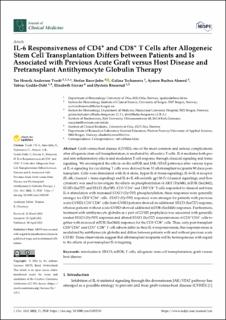IL-6 Responsiveness of CD4+ and CD8+ T Cells after Allogeneic Stem Cell Transplantation Differs between Patients and Is Associated with Previous Acute Graft versus Host Disease and Pretransplant Antithymocyte Globulin Therapy
Tvedt, Tor Henrik Anderson; Rose-John, Stefan; Tsykunova, Galina; Ahmed, Aymen B; Gedde-Dahl, Tobias; Ersvær, Elisabeth; Bruserud, Øystein
Journal article, Peer reviewed
Published version

Åpne
Permanent lenke
https://hdl.handle.net/11250/3040286Utgivelsesdato
2022Metadata
Vis full innførselSamlinger
- Department of Clinical Science [2295]
- Registrations from Cristin [9489]
Sammendrag
Graft-versus-host disease (GVHD), one of the most common and serious complications after allogeneic stem cell transplantation, is mediated by allocative T cells. IL-6 mediates both pro- and anti-inflammatory effects and modulates T cell response through classical signaling and trans-signaling. We investigated the effects on the mTOR and JAK/STAT pathways after various types of IL-6 signaling for circulating T cells were derived from 31 allotransplant recipients 90 days post-transplant. Cells were stimulated with IL-6 alone, hyper-IL-6 (trans-signaling), IL-6+IL-6 receptor (IL-6R; classical + trans-signaling) and IL-6+IL-6R+soluble gp130-Fc (classical signaling), and flow cytometry was used to investigate the effects on phosphorylation of AKT (Thr308), mTOR (Ser2442), STAT3 (Ser727) and STAT3 (Tyr705). CD3+CD4+ and CD3+C8+ T cells responded to classical and trans IL-6 stimulation with increased STAT3 (Tyr705) phosphorylation; these responses were generally stronger for CD3+CD4+ cells. STAT3 (Tyr705) responses were stronger for patients with previous acute GVHD; CD3+CD4+ cells from GVHD patients showed an additional STAT3 (Ser727) response, whereas patients without acute GVHD showed additional mTOR (Ser2448) responses. Furthermore, treatment with antithymocyte globulin as a part of GVHD prophylaxis was associated with generally weaker STAT3 (Tyr705) responses and altered STAT3 (Ser727) responsiveness of CD3+CD4+ cells together with increased mTOR (Ser2448) responses for the CD3+CD8+ cells. Thus, early post-transplant CD3+CD4+ and CD3+ CD8+ T cell subsets differ in their IL-6 responsiveness; this responsiveness is modulated by antithymocyte globulin and differs between patients with and without previous acute GVHD. These observations suggest that allotransplant recipients will be heterogeneous with regard to the effects of post-transplant IL-6 targeting.
